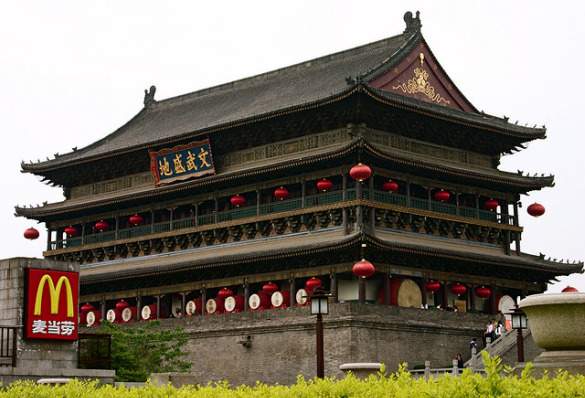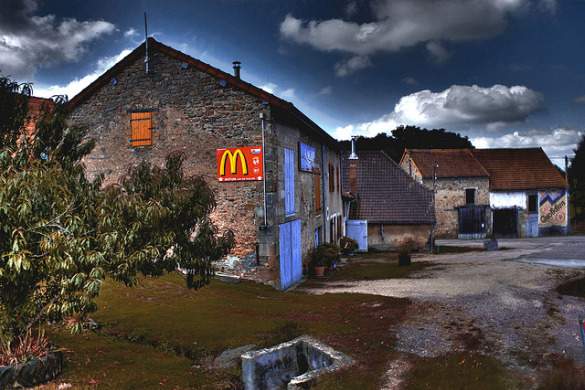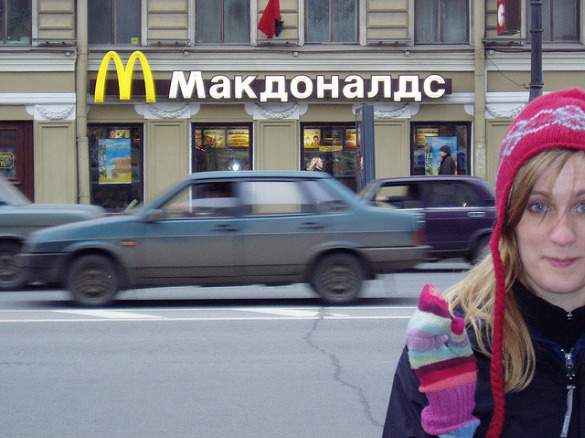The world is starting to look like America. Everywhere has KFC, McDonald’s and Burger King. Far too often, travel writers demand that we must visit a city “before it gets a McDonald’s” or “before the Americans arrive,” as if once McDonald’s and the Americans arrive that it is no longer pure, as if it is no longer worthy.
For much of my life I have felt the same way. I do not fly to Sydney to eat McNuggets. On first sight, I was disappointed to see a McDonald’s in Bergen and Madrid and Karlstad. Like most travelers, I do not want the world to be the same. I want to continue to see differences and language barriers and exotic cuisines when I travel. But today it struck me that these are my selfish wants and needs.
In our selfish ways, we want to see only bistros and boulangeries in Paris. During our week abroad, we may sit at a different bistro each day, reveling in the “authentic” Paris experience. But would we want to do this two hundred days a year? Wouldn’t we crave something other than quiche and a croque monsieur? When I dine out in my hometown of Houston, I do not always eat steak or barbecue, the most traditional of Texas foods. I count among my favorite restaurants a variety of cuisines: Italian, Thai, Japanese, Mexican, Tex-Mex, Vietnamese, as well as good ol’ American.
[social]
Why should the traveler’s desire to encounter a new experience interfere with the ability of the locals to lead a full life? If I can eat at McDonald’s near my home, why can they not? I love the french fries and the shakes. Why am I as a traveler, as an American, entitled to keep them to myself? For all of its supposed crimes against humanity, the fast food business is on to something. They make good, consistent, cheap food. If I can enjoy pad thai, sushi, tacos al carbon, bulgogi, and gnocchi in America, who am I to say that a Muscovite cannot enjoy an American hamburger, or the Dutch cannot partake in a McFish. In our wonderful country, we eat at Indian restaurants with fresh-baked naan and a tandoor oven. We buy croissants at the grocery store (and, dare I say, Burger King?). Do Americans get an exclusive right to import tasty foreign treats from abroad? Man cannot live on pizza alone. And (heaven forbid) Norwegians were relegated to a life of eating only Norwegian food. (“Oh, mom! Lutefisk again?”).
Despite the availability of nearly every world cuisine, our nation’s most popular restaurant is still McDonald’s. Why would we not export our most popular restaurant? I know all of the “Fast Food Nation” arguments, and how we blame fast food for our ever-expanding national waistline. I know that other nations fear globalization, just as Vermonters fear Wal Mart. We want to meet the friendly café owner who treats all of her employees fairly, pays a reasonable wage, and makes all of her food from scratch. We are not accustomed to that experience at home, yet we feel as if we should be entitled to that experience abroad.
But McDonald’s can be as comforting as the corner café. A McDonald’s I visited in Leiden was filled with young people laughing, as if they were filming a TV ad, complete with women in head scarfs, dark-skinned, and light-skinned youngsters alike. Some popped fries while talking on cell phones. One blond teenager busied himself wrapping a gift in pink paper for his girlfriend. Each seemed happy to be here. All arrived by their own free will. This scene would not have played out in a brown café. McDonald’s can peacefully coexist in historic neighborhoods with Michelin-starred eateries. We do not want to see McDonald’s on the Champs-Élysées, but it is there, representing the essence of the American way, the egalitarian nature of McDonald’s.
At McDonald’s there is no class structure. With many restaurants in tourist towns, you must venture far from the beaten path to ensure quality food at an affordable price. I once ate at McDonald’s in Amsterdam, long after most restaurants had closed, because I knew that they would not treat a tourist differently than a local. I knew that they would not be ripped off by an aggressive corner vendor serving me a falafel which had been cooked hours prior. They serve meals on a tourists’ schedule. At Burger King in France, you do not need to wait until noon for the restaurant to open. And, you can even eat dinner at 5:00 in Madrid!
I, myself, prefer not to eat at McDonald’s overseas, but I must admit that I have. On my first overseas trip, I arrived in Cannes on a wet and rainy March day, excited to explore. I could not have been more disappointed to see a McDonald’s just off the Boulevard de la Croisette. I wanted everything French, everything foreign. But on my second day, I ate at McDonald’s because it was among the few restaurants that I could both afford & enjoy in this overpriced, unimpressive, stuffy French seaside town. Even in the off-season, the waiters did not want to bother with a young American. At McDonald’s they took my order with a smile, and I had plenty of Euros left over to buy a bus ticket to Nice.
I do not aim to eat American fast food when I travel. In fact, I intentionally avoid it. But is it reassuring to know that, no matter where on the planet I am dropped, I can find food, tasty and affordable food, day or night. The globalization of cuisines opens up our cultures to each other. Food is an indicator of how we live differently, eat differently, experience life differently, and fast food is part of the global experience.
So for the lucky and moneyed few, who have the great privilege to travel to foreign lands, I encourage you to seek out new destinations, new cuisines, and new restaurants. For those with unlimited time and unlimited money, I encourage you , when you see that McDonald’s, to just walk on by. The rest of us just might stop by now and then, and we won’t even feel guilty about it.
Do you indulge in the occasional Big Mac, or avoid all fast food while traveling? Read more about food and travel here:
- 10 Weird Food Delicacies
- A Dish for All Seasons: What to Eat and When to Eat it Around the World
- 7 Popular Foods Named After Places
- Exciting Edibles in South America
- Unusual Snack Foods from Around the World
Learn more about author Matthew Stone and check out his BootsnAll articles here.
Photos by: EKSwitaj, yanivba, Matthew Stone, Ant and Carrie’s photos



